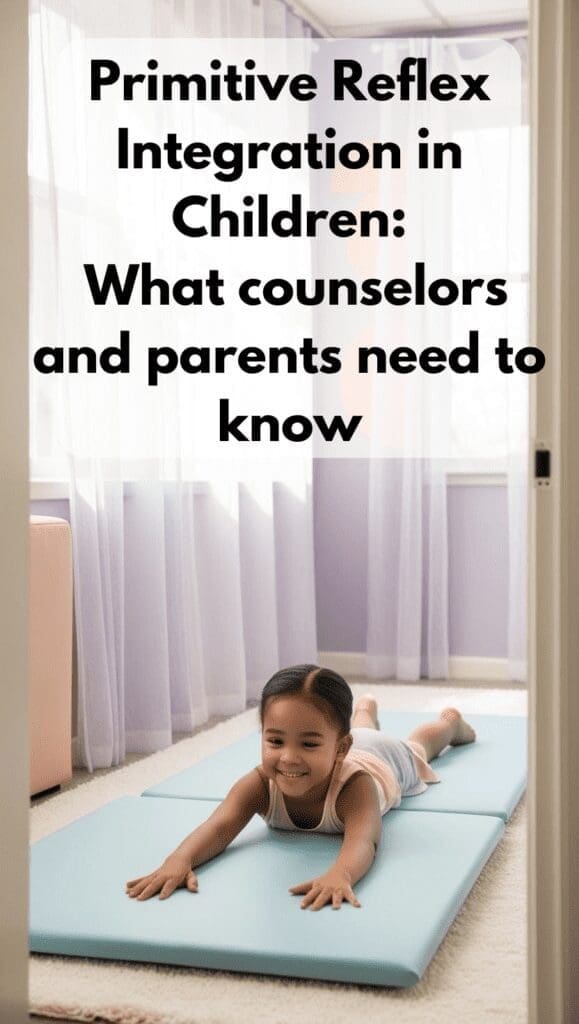Primitive reflexes are the automatic, involuntary movements that all infants are born with. They serve vital survival and developmental functions early in life. By the time a child reaches about six months old, these reflexes should naturally be integrated—or “inhibited”—as higher brain centers assume control of voluntary movement. When primitive reflexes persist beyond infancy, they can interfere with a child’s development and contribute to challenges such as ADHD, anxiety, learning disorders, and social-emotional difficulties.
This article explains what primitive reflex integration is, outlines how retained reflexes can impact behavior and learning, and details safe, engaging exercises that help integrate these reflexes. We also include real-life examples and authoritative references to support mental health professionals, educators, and parents in providing complex, effective help for children.
What Are Primitive Reflexes?
Primitive reflexes are automatic responses controlled by the brainstem. In infancy, these reflexes guide essential behaviors such as feeding and grasping. Common examples include:
- Moro (Startle) Reflex:
When startled by a sudden sound or movement, a baby will fling its arms and legs out and then pull them in. This reflex should fade by 4–6 months. - Rooting Reflex:
Gently stroking a baby’s cheek causes them to turn their head toward the stimulus, helping them locate a nipple for feeding. - Tonic Neck Reflex (ATNR):
Often seen as a “fencer’s pose,” when the baby turns its head, the arm on that side extends while the opposite arm bends. This reflex is important for developing laterality and hand–eye coordination. - Spinal Galant Reflex:
Lightly stroking one side of the baby’s lower back causes the child to arch or twist toward that side. This reflex helps initiate movement but should be integrated to avoid overactivity later. - Palmar Grasp Reflex:
Touching the baby’s palm triggers a firm grip. This reflex supports early motor development, but if it persists, it can hinder fine motor skills.
When these reflexes are integrated, the child’s nervous system becomes well-regulated, and voluntary, coordinated movement takes over.
Why Integration Matters for Psychological and Behavioral Health
When primitive reflexes persist into childhood, they can profoundly impact social-emotional, cognitive, and behavioral development. A well-integrated nervous system supports calmness, focus, and efficient learning. In contrast, retained reflexes may contribute to:
- ADHD and Inattention:
Children with retained reflexes, particularly the ATNR and Moro reflexes, may exhibit impulsivity, hyperactivity, and distractibility. For example, a persistent ATNR might cause a child’s arms to jerk when turning their head, interfering with tasks like writing or reading. Studies have found significant correlations between unintegrated reflexes and ADHD symptoms, as these reflexes disrupt the ability to maintain focus and control impulsive responses. - Anxiety and Emotional Dysregulation:
A retained Moro reflex can lead to heightened sensitivity to sensory stimuli. Children may become easily startled or overwhelmed, creating a state of chronic anxiety. When the body is in constant “fight-or-flight” mode, emotional regulation suffers, leading to mood swings, irritability, and social withdrawal. - Learning and Coordination Difficulties:
The inability to fully integrate reflexes like the ATNR or Palmar grasp can result in poor hand–eye coordination, messy handwriting, and difficulty with fine motor tasks. This can affect academic performance and cause frustration, lowering a child’s self-esteem. Additionally, issues with the Spinal Galant reflex can make sitting still and concentrating in class particularly challenging.
Consider Jack, a 7-year-old diagnosed with ADHD. Jack’s teachers report that he is easily distracted and reacts strongly to everyday classroom noises. Upon evaluation by an occupational therapist, it is discovered that Jack’s Moro and ATNR reflexes are still active. With targeted reflex integration exercises, Jack gradually learns to control these involuntary movements, leading to better focus, fewer disruptive behaviors, and improved academic performance. Similarly, a child like Mia—who becomes anxious with every sudden sound—may experience a dramatic reduction in anxiety once her reflex-driven startle responses are integrated.
By addressing retained reflexes, mental health professionals can help children overcome underlying neurological roadblocks, allowing their higher brain functions to take over. This not only improves behavior and learning but also supports overall emotional stability.
Professional Assessment: Who Should Evaluate Reflex Integration?
Identifying unintegrated primitive reflexes requires a professional assessment by trained specialists. Pediatric occupational therapists, developmental psychologists, or certified reflex integration practitioners have the expertise to perform these evaluations safely and accurately. They use simple, play-like tests that encourage the child to perform movements while observing involuntary reactions.
Examples of Assessment Techniques:
- Moro Reflex Test:
A professional might gently support the child’s head and then lower it slightly to see if the child flails their arms and legs. - ATNR Assessment:
The child is asked to extend their arms, and the examiner slowly turns the child’s head. Excessive arm extension on the side the head is turned indicates a retained ATNR. - Spinal Galant Reflex Test:
The examiner lightly strokes one side of the child’s lower back while the child is on hands and knees. A twisting or arching movement suggests the reflex is still active. - Palmar Grasp and Rooting Reflex Tests:
The specialist touches the child’s palm or cheek and observes the automatic gripping or turning responses.
These tests must be interpreted by professionals who can differentiate a reflexive response from normal behavior. Only then can a tailored intervention plan be developed.
Common Signs of Retained Reflexes and Their Impact
Moro (Startle) Reflex:
- Signs:
– Excessive startle reactions to everyday noises or movements
– High sensitivity and frequent emotional overreactions
– Constant state of anxiety or hypervigilance - Impact:
– Overactive startle response leads to chronic stress
– Difficulties in adapting to new environments or transitions
ATNR (Tonic Neck Reflex):
- Signs:
– Clumsy movements, poor handwriting, and trouble crossing the midline
– Difficulty with eye tracking and reading
– Mixed hand dominance and confusion with left/right - Impact:
– Impaired fine motor control affects academic performance
– Motor coordination issues that disrupt sports and daily tasks
Spinal Galant Reflex:
- Signs:
– Constant fidgeting and difficulty sitting still
– Lower back sensitivity and postural imbalances
– Bedwetting beyond the typical potty-training age - Impact:
– Reduced attention span and classroom disruptions
– Potential for chronic discomfort and even postural issues later
Palmar Grasp Reflex:
- Signs:
– Overly tight grip on objects and difficulty releasing them
– Weak fine motor skills and messy handwriting
– Involuntary hand clenching during tasks - Impact:
– Limits independence in tasks like dressing or writing
– Hinders precise movements needed for daily activities
Rooting Reflex:
- Signs:
– Oral hypersensitivity, excessive thumb sucking, or drooling
– Difficulties with chewing and speech delays
– Preference for soft or uniform textures in food - Impact:
– Affects feeding habits and speech development
– May lead to frustration during mealtime and social interactions
Reflex Integration Exercises: Fun and Engaging Activities
The great news is that specific exercises can help integrate retained primitive reflexes. These activities are best done under the guidance of a professional, but many can be incorporated into daily routines at home. The key is to make the exercises fun, engaging, and consistent.
Starfish Exercise (for Moro Reflex)
- How It Works:
Have the child lie on their back and slowly spread their arms and legs wide, then gently curl back into a ball. - Benefits:
This controlled movement teaches the child to replace an automatic, jarring startle with a smooth, intentional motion. - Fun Twist:
Encourage the child by saying, “Open up like a big starfish, now curl up like a little shrimp!”
Robot Walk (for ATNR)
- How It Works:
Ask the child to stand tall with arms extended in front and march in place while slowly turning their head to each side. - Benefits:
This exercise trains the child to separate head movement from arm movement, improving coordination and fine motor skills. - Fun Twist:
Turn it into a “robot march” with silly robot sounds or call it a “zombie walk” to keep the activity lighthearted.
Snow Angels (for Spinal Galant Reflex)
- How It Works:
On a soft surface, have the child lie on their back and slowly slide their arms and legs outward, then bring them back together. - Benefits:
The slow, rhythmic motion helps calm the lower back, reducing fidgeting and promoting a steady posture. - Fun Twist:
Pretend you’re drawing snow angels on a winter day and count slowly as you move.
Fine Motor Play (for Palmar Grasp Reflex)
- How It Works:
Engage the child in hand-based games using therapy putty, stress balls, or clothespin challenges that require gentle squeezing and releasing. - Benefits:
These exercises encourage voluntary control over hand movements, leading to better handwriting and tool use. - Fun Twist:
Make it a “treasure hunt” game in Play-Doh, where the child searches for hidden objects.
Oral Motor Games (for Rooting Reflex)
- How It Works:
Use activities such as blowing bubbles, drinking through a straw, or making silly faces in a mirror. - Benefits:
These fun exercises improve the child’s control over oral muscles, helping reduce hypersensitivity and improve speech. - Fun Twist:
Create a “bubble blowing contest” or challenge the child to see who can make the funniest face.
Consistent practice is crucial. Short, daily sessions (even 5–10 minutes per exercise) are often more effective than occasional longer sessions. With time, these playful routines help the child’s nervous system adapt, reducing the influence of unintegrated reflexes and allowing higher brain functions to flourish.
Bringing It All Together
Primitive reflex integration is more than just a developmental milestone—it’s a key to unlocking better behavior, improved learning, and greater emotional well-being. For children facing challenges such as ADHD, anxiety, or learning difficulties, retained reflexes can be an underlying factor that disrupts focus, coordination, and social interaction. When these reflexes are addressed through targeted, fun exercises, many children show significant improvements. For instance, professionals report that once a child’s ATNR or Moro reflex is integrated, there’s often a noticeable reduction in impulsivity and anxiety, leading to enhanced academic performance and more positive social interactions.
By recognizing the signs—such as overreacting to sounds, clumsiness, or difficulty with fine motor tasks—and seeking a professional evaluation, parents and caregivers can access the help of trained specialists. With appropriate reflex integration exercises, the child’s brain is given the opportunity to rewire and develop higher-level functions, setting the stage for lifelong benefits.
Further Reading and Resources
For those looking to learn more about primitive reflex integration and its impact on psychological health, consider these trusted resources:
- StatPearls – Primitive Reflexes:
An evidence-based medical overview discussing primitive reflexes and their developmental timeline.
Read More - Gieysztor et al., 2018 – Persistence of Primitive Reflexes (Arch. Med. Sci.):
A research study linking retained reflexes to challenges in social, educational, and psychomotor development.
Read the Abstract - Wang et al., 2023 – ADHD and Primitive Reflexes Meta-Analysis:
A systematic review showing the significant relationship between ADHD symptoms and unintegrated reflexes.
(Available through academic libraries) - Sally Goddard Blythe – Reflexes, Learning and Behavior (2005):
A practitioner-friendly book explaining how primitive reflexes affect learning and behavior, with exercises and checklists for integration. - The Autism Community in Action (TACA) – Primitive Reflex Integration Resource Guide:
An online guide for parents and professionals with clear explanations and practical tips.
Visit TACA - The OT Toolbox – Retained Primitive Reflexes:
Free articles and handouts by pediatric occupational therapists that detail signs, assessments, and integration exercises.
Explore OT Toolbox
Conclusion
Primitive reflex integration is a fundamental process that sets the stage for a child’s future success in learning, behavior, and emotional regulation. When these reflexes remain active beyond infancy, they can contribute to challenges such as ADHD, anxiety, and poor motor coordination. However, through professional assessment and engaging, playful integration exercises, children can overcome these obstacles.
For parents, understanding that a child’s clumsiness, sensitivity to noise, or difficulty with handwriting might have roots in unintegrated reflexes can be empowering. For mental health professionals, incorporating reflex integration strategies into therapy offers an additional tool to help children regulate their emotions, focus better, and develop smoother, more coordinated movements.
By working together—with trained specialists, targeted interventions, and daily practice—children can achieve better regulation of their nervous systems, paving the way for improved academic performance, stronger social interactions, and greater emotional well-being. Early intervention and consistent practice are key. With the right support, every child can overcome these early neurological roadblocks and unlock their full potential.
This article is for informational purposes and should not replace professional evaluation or therapy. If you suspect that your child has retained primitive reflexes, please consult a pediatric occupational therapist or child psychologist for a comprehensive assessment.

About the Author
Hi, I’m Eve, a former school counselor with a master’s degree in School Psychology and a passionate advocate for children and families navigating sensory challenges. As a mom of children with sensory sensitivities, I deeply understand the journey special-needs parents face, and I dedicate myself to researching and sharing practical solutions to help children thrive and feel comfortable in their bodies. My goal is also to empower counselors, therapists, and psychologists with creative strategies and supportive resources to enrich their everyday practice. When I’m not writing or exploring new therapeutic approaches, you’ll find me spending quality time with my family and continually seeking inspiration from everyday moments.




